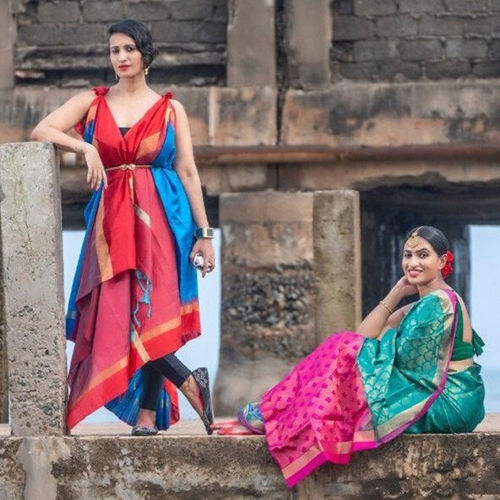Ramya Rao & Kavea R Chavali
Founders
Kalaneca
Every handwoven weave has a story
The journey of Kalaneca (kala-Art, Neca- Nikaah) formally began in 2018 as the culmination of the collective dream of twin sisters - Ramya Rao and Kavea R Chavali, inspired by their mother - Lata Rao. Paulami Chatterjee spoke to the designer duo to understand the journey of their sari brand.
Fibre2Fashion: What was the inspiration that led to the formation/founding of the brand?
Ramya Rao & Kavea R Chavali:
We were always exposed to handwoven weaves. Hailing from a defence family, our parents would encourage us to understand the culture of the place we travelled to and each time we would bring back something handmade or handwoven from the places visited. We also realised that a powerloom sari might be comfortable on the pocket but highly uncomfortable to drape. After engaging conversations and watching the sari handwoven on a loom, we realised every handwoven weave has a story and a touch of love.
We are now headquartered at Mumbai and Kakinada
F2F: What is the USP of your products?
RR&KRC:
Our premium handwoven saris come in eclectic and unique colour combinations. The saris are customised for every mood, profession, and personality.
F2F: Which are your major markets in India and abroad?
RR&KRC:
Southern India, West Bengal and Delhi
F2F: What kind of brand building strategies do you implement?
RR&KRC:
We try to bring out the brand’s narrative of ‘Wear Your Power’ strongly through various concept shoots
F2F: Which are the categories the brand is into?
RR&KRC:
Womenswear
F2F: Who are your target audience?
RR&KRC:
Our target audience are women aged 25-60 wishing to express their personalities through versatility of a sari.
F2F: Which category sells the most and what is the price point?
RR&KRC:
Our silk saris are in high demand.
F2F: What are the price points of your saris?
RR&KRC:
The price points are as follows: cotton saris - Rs 2,500; silk and tissue saris - Rs 6,000; customised uppada jamdani silk saris - Rs 50,000 onwards.
F2F: What is your retail and web presence like?
RR&KRC:
We only have online presence as of now. We sell through our own website, Instagram, Facebook, Twitter etc.
F2F: Which other product categories do you plan to move into future?
RR&KRC:
We plan to explore the possibilities of gifting solutions by providing a whole package around a sari that includes blouses, petticoats and jewellery.
F2F: What has been the impact of Covid in terms of sales, staff cutdown, rentals, stocks etc?
RR&KRC:
Our sales were hit badly; 40 per cent of the collection remained unsold. To protect weavers from unemployment and to ensure that the production kept running, the saris were sold at maximum sale price.
F2F: Where are your manufacturing facilities based at?
RR&KRC:
Our saris are handwoven in Andhra Pradesh villages and then sent to Kakinada or Mumbai from where they are shipped across the world depending on the photoshoot plans.
F2F: What is the annual production capacity?
RR&KRC:
We produce 8 curated and capsuled collections every year.
F2F: What kind of machinery does your manufacturing facility boast of?
RR&KRC:
Everything is on the handloom.
F2F: Sustainability and circularity are the buzz words today. How do you incorporate them into your product lines?
RR&KRC:
We ensure that there is no usage of plastic/ polyester in creating its saris unless a customer demands the sari to be wrapped in plastic to keep it safe. The bags are handwoven with muslin cloth and the exterior packaging involves a plastic bag that can be reused and recycled. Also, a seed plant paper is sent to the customer so that he/she can plant the paper further. The intention is to go completely plastic free. (PC)



20230103183907.png)





_8.JPG)




